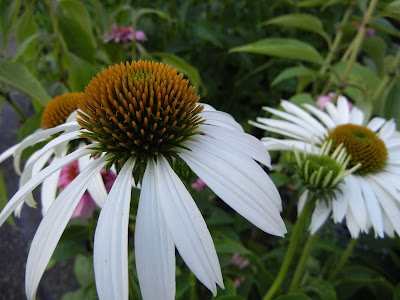National Pollinator Week has arrived! Now is the perfect
time to celebrate hummingbirds, butterflies, bees, beetles, moths, birds, bats, and other pollinators that keep our environment thriving and our gardens
blooming. Here are some great ways to act in your own gardens and communities.
 |
| Have your habitat registered for Monarch Butterflies |
1.
Plant native plants like bee balm, black-eyed
Susans, milkweed, clethra, and scores of other plants that have naturally evolved
alongside soils, birds, and other animals, and our environment.
 |
| My backyard Clethra was a magnet for Swallowtail butterflies |
Annuals can also be used for attracting
pollinators. I love Black and Blue Salvia for attracting hummingbirds, lantana
for butterflies, and zinnias for bees and other pollinators.
3. Build a bee hotel. I did not have to do that; I
noticed bees living in my firewood stack and in some old fence posts, providing
their own ‘construction’ for a hotel.
 |
| Our signage identifies pollinator attracting plants, and natives |
4.
Avoid pesticides, especially when plants are in bloom.
If you must use pesticides, look for safe organic options and always follow the label instructions.
 |
| Many pesticides are labeled for pollinator protection |
5. Include a water source in the garden. A shallow
dish with pebbles or a birdbath can provide a habitat for healthy pollinators. A small pond is another way to attract pollinators to the garden.
 |
| A new pond and the surrounding landscape will be a wonderful habitat for pollinators |
K Gardens can be a little messy.
Pollinators use leaf litter and hollow stems for egg laying and nesting.
 |
| This Black Swallowtail caterpillar keeps my parsley from growing too large. |
For your community:
1.
Host a pollinator garden installation at a local
school, park, or business.
 |
| Host a butterfly release |
2. Volunteer and learn with local nature groups, including Oregon Ridge Park, Cromwell Valley Park, Cylburn Arboretum, Green Towson
Alliance, The Wild Ones of Greater Baltimore, and other nature-affiliated groups.
3.
Provide seminars to local groups and/or join with local garden centers to reach out to the community. We worked with The Wild Ones of Greater Baltimore and the Baltimore County Master Gardeners to provide several seminars in 2024 and 2025.
Learn more through books like Bringing Nature Home and
Nature’s Best Hope by Doug Tallamy.
Most importantly, enjoy this week and take notice of the many pollinators that help provide us with beauty, food, and an amazing world.













































